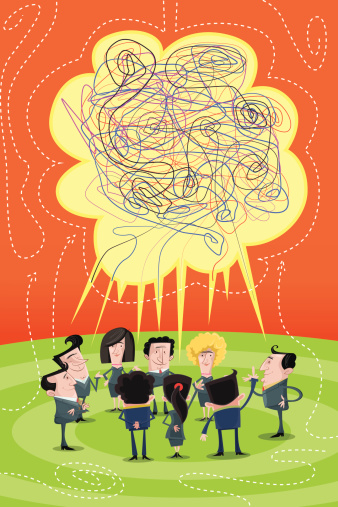
Not all divorces are related to alcohol abuse, but the percentage is fairly high. I don’t have any scientific study, but my own experience of observing thousands of divorces over three decades, I have found that nearly half of all divorces involve, at minimum, allegations of some type of alcohol abuse. From observing the interactions in these cases, as well as working with professionals in these areas, here are the most important observations I have made:
If you think there is a problem, you are probably right.
If one party truly believes there is alcohol abuse in the marriage, there is a very high probability that they are right. Yes, it is true that divorce can lead to many false allegations, particularly if you are in an adversarial divorce. However, while divorcing couples often exaggerate most flaws of the other spouse, I have found that, largely because of co-dependency dynamics, many spouses actually under report alcohol abuse.
If your spouse thinks you have a problem, you certainly have a problem.
How can I be certain? Easy. First, as indicated above, if your spouse truly thinks you have a problem, there is a high probably they are right. Moreover, even if they are wrong, their belief that you have a problem is, by itself, a major problem. In either case, the solution often points to undergoing a thorough and honest alcohol assessment. If you can get at the truth, everyone wins.
A spouse stopping or cutting back alcohol use during the divorce proves little. Often the spouse believed to have an alcohol problem will either stop using alcohol or cut back on alcohol use as the threat of divorce draws near. While this may (or may not) be a welcome reprieve for the family, it generally means very little in terms of determining the existence of a problem. Indeed, most chemical dependency counselors see frequent failed attempts to stop or cut back as being one of the indicators of alcoholism. Moreover, for most alcoholics, stopping drinking does not necessarily end the alcoholic behavior.
Sometimes alcohol use during divorce can be “situational”.
Divorce usually does not come up suddenly, but rather creeps into homes over months or years. As it creeps closer, the sadness or fear can sometimes cause non-alcoholics to temporarily abuse alcohol during this difficult time. While temporary abuse of alcohol still has serious consequences the long-term impact can be quite different than addressing alcoholism.
If alcohol is an issue, you need a process in which honesty can be rewarded. Divorce processes differ. Traditional divorces that operate in the shadow of the courthouse can sometimes seem to punish honesty in the sense that the person suspected of alcohol abuse feels compelled to either deny or minimize the allegations for fear of losing time with their children. On the other hand, processes such as Collaborative Law or mediation, by operating outside of court, can provide a safe place where alcohol use can be addressed as a health issue and not as a piece of evidence. To learn more about these options go to
www.Collaborativelaw.org or www.divorcechoice.com.
 As I listened to the appalling news out of Ferguson, MO, last week, I was especially struck by two things:
First, a veteran police officer, a retired chief of a municipal department, shared an observation that his officers made during unrest in his city, that when they were deployed in riot gear, officers invariably discovered that the situation became riotous. But when they met protestors wearing only their regular uniforms, they were able to talk to them and defuse many situations.
Secondly, early last week, Missouri Governor Jay Nixon put State Troopers under the command of Capt. Ronald S. Johnson, who grew up in the area, in charge of the police effort in Ferguson. Capt. Johnson, as pictured on the front page of the August 15th N.Y. Times, wore only his regular Summer uniform. He walked with protestors in the streets; he listened to them explain long-standing grievances. And the temperature in Ferguson cooled perceptibly–before additional tear gas and rubber bullets reignited passions.
I am not a cop. But the retired police chief–and Capt. Johnson–and I–all know from long experience that you will find trouble if you go looking for it.
Fortunately, my experiences as a divorce lawyer lack both rubber bullets and tear gas, but they are accompanied by strong emotions, usually expressed in the denigration of my client’s spouse. My client recites how dishonest, abusive, or uncaring the spouse is; how neglectful or clueless he or she is. It’s the opposite of the old lyric, “lookin’ for gold in a silver mine.” If those negative emotions bubble over, they’re invariably met with–SURPRISE!–the same feelings on the other side! And the case becomes even more contentious. The bigger waste, overall, is that the couple seems to believe that the family court system cares about this emotion. Apparently they believe that if the fight becomes bitter enough, someone will “win”. These folks could have been the inspiration for Elton John’s lyrics in “Honky Cat”:
“It’s like trying to find gold in a silver mine. It’s like trying to drink whiskey from a bottle of wine.”
Collaborative Process was conceived as a problem-solving exercise, based on a belief that husbands and wives might put their children’s welfare before their own. When I can get my client to take that leap of faith, s/he is often astounded to discover that, because they’re not spending the time fighting, both of them are able to make decisions that directly benefit the entire family. When my client starts out believing that their spouse also wants to complete the process and care for their children, they discover–SURPRISE!–that the spouses do. And when that happens, they’re more willing to listen to the variety of ways in which that could occur. Time and energy are now spent devising productive ways to reorganize their family.
If you’re looking for peace by waging war, don’t expect to find it. If, on the other hand, you start out waging peace . . .
As I listened to the appalling news out of Ferguson, MO, last week, I was especially struck by two things:
First, a veteran police officer, a retired chief of a municipal department, shared an observation that his officers made during unrest in his city, that when they were deployed in riot gear, officers invariably discovered that the situation became riotous. But when they met protestors wearing only their regular uniforms, they were able to talk to them and defuse many situations.
Secondly, early last week, Missouri Governor Jay Nixon put State Troopers under the command of Capt. Ronald S. Johnson, who grew up in the area, in charge of the police effort in Ferguson. Capt. Johnson, as pictured on the front page of the August 15th N.Y. Times, wore only his regular Summer uniform. He walked with protestors in the streets; he listened to them explain long-standing grievances. And the temperature in Ferguson cooled perceptibly–before additional tear gas and rubber bullets reignited passions.
I am not a cop. But the retired police chief–and Capt. Johnson–and I–all know from long experience that you will find trouble if you go looking for it.
Fortunately, my experiences as a divorce lawyer lack both rubber bullets and tear gas, but they are accompanied by strong emotions, usually expressed in the denigration of my client’s spouse. My client recites how dishonest, abusive, or uncaring the spouse is; how neglectful or clueless he or she is. It’s the opposite of the old lyric, “lookin’ for gold in a silver mine.” If those negative emotions bubble over, they’re invariably met with–SURPRISE!–the same feelings on the other side! And the case becomes even more contentious. The bigger waste, overall, is that the couple seems to believe that the family court system cares about this emotion. Apparently they believe that if the fight becomes bitter enough, someone will “win”. These folks could have been the inspiration for Elton John’s lyrics in “Honky Cat”:
“It’s like trying to find gold in a silver mine. It’s like trying to drink whiskey from a bottle of wine.”
Collaborative Process was conceived as a problem-solving exercise, based on a belief that husbands and wives might put their children’s welfare before their own. When I can get my client to take that leap of faith, s/he is often astounded to discover that, because they’re not spending the time fighting, both of them are able to make decisions that directly benefit the entire family. When my client starts out believing that their spouse also wants to complete the process and care for their children, they discover–SURPRISE!–that the spouses do. And when that happens, they’re more willing to listen to the variety of ways in which that could occur. Time and energy are now spent devising productive ways to reorganize their family.
If you’re looking for peace by waging war, don’t expect to find it. If, on the other hand, you start out waging peace . . .  As I listened to the appalling news out of Ferguson, MO, last week, I was especially struck by two things:
First, a veteran police officer, a retired chief of a municipal department, shared an observation that his officers made during unrest in his city, that when they were deployed in riot gear, officers invariably discovered that the situation became riotous. But when they met protestors wearing only their regular uniforms, they were able to talk to them and defuse many situations.
Secondly, early last week, Missouri Governor Jay Nixon put State Troopers under the command of Capt. Ronald S. Johnson, who grew up in the area, in charge of the police effort in Ferguson. Capt. Johnson, as pictured on the front page of the August 15th N.Y. Times, wore only his regular Summer uniform. He walked with protestors in the streets; he listened to them explain long-standing grievances. And the temperature in Ferguson cooled perceptibly–before additional tear gas and rubber bullets reignited passions.
I am not a cop. But the retired police chief–and Capt. Johnson–and I–all know from long experience that you will find trouble if you go looking for it.
Fortunately, my experiences as a divorce lawyer lack both rubber bullets and tear gas, but they are accompanied by strong emotions, usually expressed in the denigration of my client’s spouse. My client recites how dishonest, abusive, or uncaring the spouse is; how neglectful or clueless he or she is. It’s the opposite of the old lyric, “lookin’ for gold in a silver mine.” If those negative emotions bubble over, they’re invariably met with–SURPRISE!–the same feelings on the other side! And the case becomes even more contentious. The bigger waste, overall, is that the couple seems to believe that the family court system cares about this emotion. Apparently they believe that if the fight becomes bitter enough, someone will “win”. These folks could have been the inspiration for Elton John’s lyrics in “Honky Cat”:
“It’s like trying to find gold in a silver mine. It’s like trying to drink whiskey from a bottle of wine.”
Collaborative Process was conceived as a problem-solving exercise, based on a belief that husbands and wives might put their children’s welfare before their own. When I can get my client to take that leap of faith, s/he is often astounded to discover that, because they’re not spending the time fighting, both of them are able to make decisions that directly benefit the entire family. When my client starts out believing that their spouse also wants to complete the process and care for their children, they discover–SURPRISE!–that the spouses do. And when that happens, they’re more willing to listen to the variety of ways in which that could occur. Time and energy are now spent devising productive ways to reorganize their family.
If you’re looking for peace by waging war, don’t expect to find it. If, on the other hand, you start out waging peace . . .
As I listened to the appalling news out of Ferguson, MO, last week, I was especially struck by two things:
First, a veteran police officer, a retired chief of a municipal department, shared an observation that his officers made during unrest in his city, that when they were deployed in riot gear, officers invariably discovered that the situation became riotous. But when they met protestors wearing only their regular uniforms, they were able to talk to them and defuse many situations.
Secondly, early last week, Missouri Governor Jay Nixon put State Troopers under the command of Capt. Ronald S. Johnson, who grew up in the area, in charge of the police effort in Ferguson. Capt. Johnson, as pictured on the front page of the August 15th N.Y. Times, wore only his regular Summer uniform. He walked with protestors in the streets; he listened to them explain long-standing grievances. And the temperature in Ferguson cooled perceptibly–before additional tear gas and rubber bullets reignited passions.
I am not a cop. But the retired police chief–and Capt. Johnson–and I–all know from long experience that you will find trouble if you go looking for it.
Fortunately, my experiences as a divorce lawyer lack both rubber bullets and tear gas, but they are accompanied by strong emotions, usually expressed in the denigration of my client’s spouse. My client recites how dishonest, abusive, or uncaring the spouse is; how neglectful or clueless he or she is. It’s the opposite of the old lyric, “lookin’ for gold in a silver mine.” If those negative emotions bubble over, they’re invariably met with–SURPRISE!–the same feelings on the other side! And the case becomes even more contentious. The bigger waste, overall, is that the couple seems to believe that the family court system cares about this emotion. Apparently they believe that if the fight becomes bitter enough, someone will “win”. These folks could have been the inspiration for Elton John’s lyrics in “Honky Cat”:
“It’s like trying to find gold in a silver mine. It’s like trying to drink whiskey from a bottle of wine.”
Collaborative Process was conceived as a problem-solving exercise, based on a belief that husbands and wives might put their children’s welfare before their own. When I can get my client to take that leap of faith, s/he is often astounded to discover that, because they’re not spending the time fighting, both of them are able to make decisions that directly benefit the entire family. When my client starts out believing that their spouse also wants to complete the process and care for their children, they discover–SURPRISE!–that the spouses do. And when that happens, they’re more willing to listen to the variety of ways in which that could occur. Time and energy are now spent devising productive ways to reorganize their family.
If you’re looking for peace by waging war, don’t expect to find it. If, on the other hand, you start out waging peace . . . 



 Not all divorces are related to alcohol abuse, but the percentage is fairly high. I don’t have any scientific study, but my own experience of observing thousands of divorces over three decades, I have found that nearly half of all divorces involve, at minimum, allegations of some type of alcohol abuse. From observing the interactions in these cases, as well as working with professionals in these areas, here are the most important observations I have made:
If you think there is a problem, you are probably right.
If one party truly believes there is alcohol abuse in the marriage, there is a very high probability that they are right. Yes, it is true that divorce can lead to many false allegations, particularly if you are in an adversarial divorce. However, while divorcing couples often exaggerate most flaws of the other spouse, I have found that, largely because of co-dependency dynamics, many spouses actually under report alcohol abuse.
If your spouse thinks you have a problem, you certainly have a problem.
How can I be certain? Easy. First, as indicated above, if your spouse truly thinks you have a problem, there is a high probably they are right. Moreover, even if they are wrong, their belief that you have a problem is, by itself, a major problem. In either case, the solution often points to undergoing a thorough and honest alcohol assessment. If you can get at the truth, everyone wins.
A spouse stopping or cutting back alcohol use during the divorce proves little. Often the spouse believed to have an alcohol problem will either stop using alcohol or cut back on alcohol use as the threat of divorce draws near. While this may (or may not) be a welcome reprieve for the family, it generally means very little in terms of determining the existence of a problem. Indeed, most chemical dependency counselors see frequent failed attempts to stop or cut back as being one of the indicators of alcoholism. Moreover, for most alcoholics, stopping drinking does not necessarily end the alcoholic behavior.
Sometimes alcohol use during divorce can be “situational”.
Divorce usually does not come up suddenly, but rather creeps into homes over months or years. As it creeps closer, the sadness or fear can sometimes cause non-alcoholics to temporarily abuse alcohol during this difficult time. While temporary abuse of alcohol still has serious consequences the long-term impact can be quite different than addressing alcoholism.
If alcohol is an issue, you need a process in which honesty can be rewarded. Divorce processes differ. Traditional divorces that operate in the shadow of the courthouse can sometimes seem to punish honesty in the sense that the person suspected of alcohol abuse feels compelled to either deny or minimize the allegations for fear of losing time with their children. On the other hand, processes such as Collaborative Law or mediation, by operating outside of court, can provide a safe place where alcohol use can be addressed as a health issue and not as a piece of evidence. To learn more about these options go to
Not all divorces are related to alcohol abuse, but the percentage is fairly high. I don’t have any scientific study, but my own experience of observing thousands of divorces over three decades, I have found that nearly half of all divorces involve, at minimum, allegations of some type of alcohol abuse. From observing the interactions in these cases, as well as working with professionals in these areas, here are the most important observations I have made:
If you think there is a problem, you are probably right.
If one party truly believes there is alcohol abuse in the marriage, there is a very high probability that they are right. Yes, it is true that divorce can lead to many false allegations, particularly if you are in an adversarial divorce. However, while divorcing couples often exaggerate most flaws of the other spouse, I have found that, largely because of co-dependency dynamics, many spouses actually under report alcohol abuse.
If your spouse thinks you have a problem, you certainly have a problem.
How can I be certain? Easy. First, as indicated above, if your spouse truly thinks you have a problem, there is a high probably they are right. Moreover, even if they are wrong, their belief that you have a problem is, by itself, a major problem. In either case, the solution often points to undergoing a thorough and honest alcohol assessment. If you can get at the truth, everyone wins.
A spouse stopping or cutting back alcohol use during the divorce proves little. Often the spouse believed to have an alcohol problem will either stop using alcohol or cut back on alcohol use as the threat of divorce draws near. While this may (or may not) be a welcome reprieve for the family, it generally means very little in terms of determining the existence of a problem. Indeed, most chemical dependency counselors see frequent failed attempts to stop or cut back as being one of the indicators of alcoholism. Moreover, for most alcoholics, stopping drinking does not necessarily end the alcoholic behavior.
Sometimes alcohol use during divorce can be “situational”.
Divorce usually does not come up suddenly, but rather creeps into homes over months or years. As it creeps closer, the sadness or fear can sometimes cause non-alcoholics to temporarily abuse alcohol during this difficult time. While temporary abuse of alcohol still has serious consequences the long-term impact can be quite different than addressing alcoholism.
If alcohol is an issue, you need a process in which honesty can be rewarded. Divorce processes differ. Traditional divorces that operate in the shadow of the courthouse can sometimes seem to punish honesty in the sense that the person suspected of alcohol abuse feels compelled to either deny or minimize the allegations for fear of losing time with their children. On the other hand, processes such as Collaborative Law or mediation, by operating outside of court, can provide a safe place where alcohol use can be addressed as a health issue and not as a piece of evidence. To learn more about these options go to 




